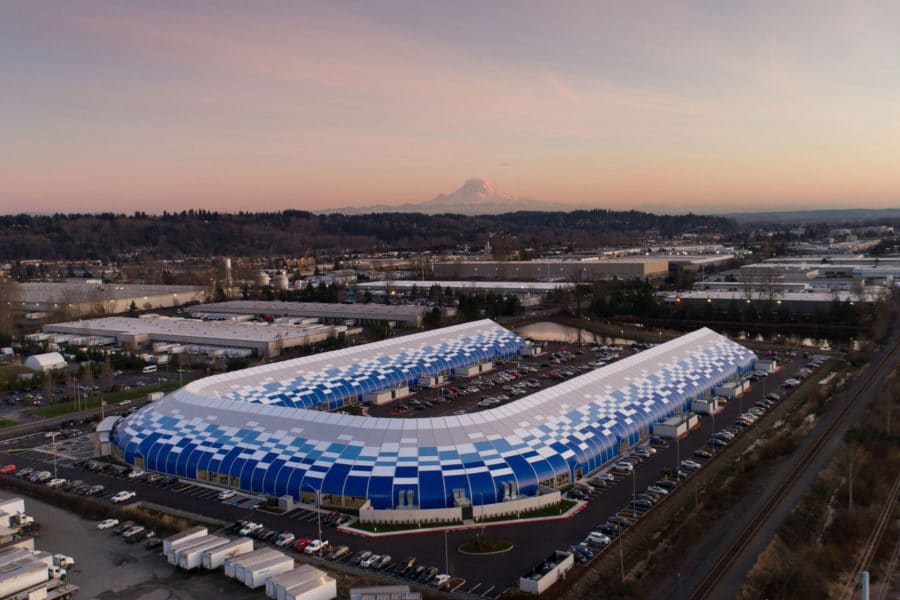Story at a glance:
- There are three types of architectural fabric structures: air-supported, frame, and tensile.
- Architectural fabric structures can be temporary, semi-permanent, or permanent.
From their contemporary debut at the Montreal Expo in 1967 until now, architectural fabric structures (AFS) consist of fabric membranes, typically made of high-density polyethylene (HDPE) or polyvinyl chloride (PVC), suspended or stretched over steel or aluminum frames.
In this articule consider the major types of architectural fabric structures highlighting their sustainability features.
What are Architectural Fabric Structures?
AFS may be temporary, semi-permanent, or permanent structures serving a wide variety of purposes including event shelters, sports arenas, or office space.
Many of today’s AFS resemble traditional brick-and-mortar buildings—in function at least—so much so the distinction between the two is becoming blurred. “From the inside you would never know you are in a fabric structure,” Frank Bradenburg of Shelter Rite Architectural Fabrics previously wrote for gb&d.
Architectural fabric structures fit the definition of flexible buildings materials as described by the intent of the USGBC standard on design by flexibility: “Conserve resources associated with the construction and management of buildings by designing for flexibility and ease of future adaptation and for the service life of components and assemblies.” Constructing an AFS is worth one LEED v4 point.
The flexible nature of the membrane fabrics used in AFS affords architects the opportunity to create elegant, airy, or sculptural structures in their designs. Note that the AFS choice may require an architect to work with an AFS manufacturer in both the design and construction phases. Likewise, achieving building code compliance may involve a consultation with an expert.
2 Categories of Architectural Fabric Structures

Photo courtesy of Shelter-Rite Architectural Fabrics
There are two broad categories of architectural fabric structures—tensile and tension.
Tensile. AFS with distinct artistic features fall in the tensile category. Just glancing at them from afar, you’ll be struck by how unique they are. The Denver International Airport roof is probably the most stunning tensile AFS in the US.
Tensile structures are typically supported by a central pole often in conjunction with structural framing to support the tension in the fabric. One arrangement consists of cables attached to solid structures like masts or poles with the fabric stretched between supports.
A second variation is composed of a mesh of cables that scaffolds the membrane rather than stretching it. In other words, the membrane is positioned over the cable mesh. In tensile structures, the membrane itself also adds structural support between the vast expanses of the frame.
The membranes in tensile structures include PVC or fiberglass. Tensile structures are frequently installed as shade canopies. Since they are custom-made, they are more expensive than other types of architectural fabric structures.
Tension. Architectural tension fabric structures, on the other hand, resemble brick and mortar buildings more closely compared to tensile structures. Their walls are often flat-paneled yet still fall in the flexible materials category.
AFS in this group feature their membrane stretched over a galvanized (corrosive-resistant) steel frame. A difference with the tensile structures is that the membrane in an architectural tension fabric structure cannot be included in the structural support system of the structure according to code. The steel frame itself provides the structural support for the entire structure. The fabric serves as exterior cladding protecting the building by keeping wind and rain out.
3 Types of Architectural Fabric Structures
The tensile category of architectural fabric structures explained in the preceding section contains two very different types of architectural fabric structures—air-supported (pneumatic) structures, and those that share the category name (i.e., tensile structures).
Along with the tension (frame) structure type also discussed above, there are three general types of architectural fabric structures. Here’s a brief description of each one.
Air-supported (pneumatic). Lacking any interior metal frame, pneumatic AFS relies on internal air pressure to support the membrane. Electrical air blowers supply the internal pressure. To maintain its shape, the structure must be completely airtight.
Tensile. With either cables plus solid poles or a mesh of cables, the membrane is stretched or suspended over the supports, respectively. Known for their unique designs, tensile AFS are the most expensive type when comparing similarly sized structures. “Often the structure incorporates 3D shapes that create a statement,” Bradenburg told gb&d.
Frame. Also called a tension AFS, the frame type is characterized by a corrosion-resistant steel frame with either a bent or open web truss design. Bent trusses are less expensive and can be more quickly constructed. Open web trusses offer a higher weight-bearing capacity which is important in snowy regions. Fabric is stretched over the frame structure.
Benefits of Architectural Fabric Structures
There are multiple benefits of architectural fabric structures. Here are several:
● Cost-effective
● Time-saving
● Energy-efficient
● Portable
● Durable
● Reusable
● Customizable
● Reduces interior lighting costs
● Can be retrofitted to existing buildings as insulation
Which Architectural Fabric Structure is Best?
The best architectural fabric structure depends on your intended use and on the conditions of the site where you plan to install it.
Architectural tension (frame) fabric structures are most suitable when you need a structure for these reasons:
● Industrial activities involved with heavy construction or mining
● Must function in extreme weather
● A high interior height needed for equipment
All types of architectural fabric structures can remain functional for extended periods of time, even decades if well-maintained.

